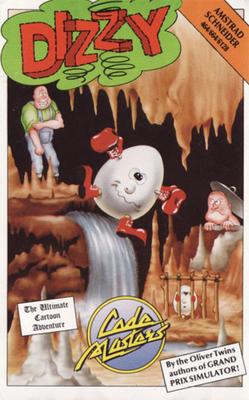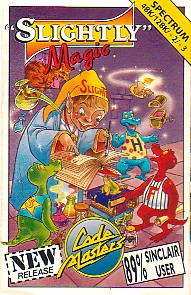
The NewZealand Story is a platform game developed and released in arcades by Taito in 1988. The concept and setting were inspired by a holiday trip in New Zealand by one of the Taito programmers. The player controls Tiki (ティキ), a kiwi who must save his girlfriend Phee Phee (ピューピュー) and several of his other kiwi chick friends who have been kidnapped by a large blue leopard seal. While avoiding enemies, the player has to navigate a scrolling maze-like level, at the end of which they release one of Tiki's kiwi chick friends trapped in a cage. In 2007, the arcade game received a remake for the Nintendo DS under the title New Zealand Story Revolution.

Dizzy is a series of video games, created by the Oliver Twins and published by Codemasters. It was one of the most successful British video game franchises of the late 1980s and early 1990s. Originally created for the ZX Spectrum and Amstrad CPC, the series appeared on multiple home computer and video game console formats, with over a dozen games being published between 1987 and 1992.

Jet Set Willy is a platform video game written by Matthew Smith for the ZX Spectrum home computer. It was published in 1984 by Software Projects and ported to most home computers of the time.

Wonder Boy in Monster Land, known by its original arcade release as Wonder Boy: Monster Land, is a platform video game developed by Westone Bit Entertainment and released by Sega in Japanese arcades in 1987 and for the Master System in 1988, with a number of other home computer and console ports following. The game is the sequel to the 1986 game Wonder Boy and takes place eleven years after the events in the previous game. After enjoying over a decade of peace on Wonder Land following the defeat of the evil King by Tom-Tom, later bestowed the title "Wonder Boy", a fire-breathing dragon called the MEKA dragon appeared; he and his minions conquered Wonder Land, turning it into "Monster Land". The people, helpless due to their lack of fighting skill, call for Wonder Boy, now a teenager, to destroy the monsters and defeat the MEKA dragon. Players control Wonder Boy through twelve linear levels as he makes his way through Monster Land to find and defeat the MEKA dragon. Players earn gold by defeating enemies and buy weapons, armor, footwear, magic, and other items to help along the way.

Sabre Wulf is an action-adventure game released by British video game developer Ultimate Play the Game for the ZX Spectrum home computer in 1984. The player navigates the pith-helmeted Sabreman through a 2D jungle maze while collecting amulet pieces to bypass the guardian at its exit. The player does not receive explicit guidance on how to play and is left to decipher the game's objectives through trial and error. Sabreman moves between the maze's 256 connected screens by touching the border where one screen ends and another begins. Each screen is filled with colourful flora, enemies that spawn at random, and occasional collectibles.

Jetpac is a shooter video game developed and published by Ultimate Play the Game and released for the ZX Spectrum and VIC-20 in 1983 and the BBC Micro in 1984. It is the first game to be released by Ultimate Play the Game, the company which later became Rare. The game follows Jetman as he must rebuild his rocket in order to explore different planets, while simultaneously defending against hostile aliens. It was written by Ultimate co-founder Chris Stamper with graphics designed by his brother, Tim Stamper. Reviewers praised Jetpac's presentation and gameplay, and it won "Game of the Year" at the Golden Joystick Awards in 1983.

Knight Lore is a 1984 action-adventure game developed and published by Ultimate Play the Game, and written by company founders Chris and Tim Stamper. The game is known for its use of isometric graphics, which it further popularized in video games. In Knight Lore, the player character Sabreman has forty days to collect objects throughout a castle and brew a cure to his werewolf curse. Each castle room is depicted in monochrome on its own screen and consists of blocks to climb, obstacles to avoid, and puzzles to solve.

Spy vs. Spy is a video game written by Michael Riedel for the Commodore 64 and published by First Star Software in 1984. A port for the Atari 8-bit computers was released simultaneously. It is a two-player, split-screen game, based on Mad magazine's long-running cartoon strip Spy vs. Spy, about the slapstick antics of two spies trying to kill each other with improbably elaborate traps and weapons.

Mercenary is a 3D action-adventure game written for the Atari 8-bit computers and published by Novagen Software in 1985. It was converted to the Commodore 64, ZX Spectrum, Amstrad CPC, Atari ST, Amiga, and Commodore 16/116/Plus/4. The game uses vector graphics renderings of vast, sparse environments and has various methods of completing the game. It was also released as Mercenary: Escape from Targ and Mercenary: A Flight Simulator Adventure.

Dizzy – The Ultimate Cartoon Adventure is an adventure-platform game, the first video game featuring the character Dizzy, an anthropomorphic egg. The game was designed by two British brothers, the Oliver Twins. Dizzy was published by Codemasters and was released in 1987.

Underwurlde is a 1984 action-adventure platform video game in the Sabreman series by Ultimate Play the Game for the ZX Spectrum and Commodore 64. The player controls the adventurer Sabreman as he jumps between platforms in a castle and its caverns to find an escape past the exit guardians. Underwurlde features about 600 flip screen areas. Unlike other games of its time, Sabreman is not injured when touched by enemies and is instead knocked backwards. Underwurlde is the second game in the series, between Sabre Wulf and Knight Lore, and released shortly before the latter for the ZX Spectrum in late 1984. Another developer, Firebird, ported the game to the Commodore 64 the next year.

Magicland Dizzy is a platform adventure game published in Europe in 1990 by Codemasters for the ZX Spectrum, Commodore 64 and Amiga platforms. By 1992 there were also MS-DOS, Atari ST and Amstrad CPC versions available. It is the sixth game in the Dizzy series, and the fourth adventure-based Dizzy title. The story, set in a fantasy world called Magicland, follows on from the events of Fantasy World Dizzy, the previous adventure title. In Magicland Dizzy the player controls Dizzy, an egg-shaped character, who is trying to save six of his friends who have been placed under spells by the Evil Wizard Zaks.

Crystal Kingdom Dizzy is an adventure video game featuring the character Dizzy released in December 1992 by Codemasters. The Oliver Twins – who were heavily involved in the design and programming of previous Dizzy games – had less involvement with this one.

Slightly Magic is an action-adventure game published in 1991 by Codemasters for the Amiga, Amstrad CPC, Atari ST, Commodore 64 and ZX Spectrum. It was written by Colin Jones, author of Rock Star Ate My Hamster.
Magic Knight is a computer game franchise created by freelance programmer David Jones originally for the 1985 game Finders Keepers on the Mastertronic budget label. Finders Keepers is a flip-screen platform game released on the ZX Spectrum, Amstrad CPC, MSX and Commodore 64. The game spawned three additional sequels on the Mastertronic Added Dimension budget label: Spellbound (1985), Knight Tyme (1986) and Stormbringer (1987). The three sequels are far less action-orientated, being effectively graphic adventure games using a basic menu system ("Windimation") for Magic Knight to interact with characters and items instead of typed commands.

Spellbound is a video game that was designed and programmed by David Jones with music by Rob Hubbard and released in 1985 for the ZX Spectrum and Amstrad CPC home computers. Versions for the Commodore 64 and the Atari 8-bit computers and an enhanced 128K Spectrum version with music and additional graphics were all released in 1986. Unlike the other Magic Knight games, Spellbound was never released for the MSX system back in 1985, but an authorized version was finally released by Tracy Lewis in 2023. It is the second game in the Magic Knight series and was published by Mastertronic as part of their Mastertronic Added Dimension label.

Wonder Boy is a 1986 platform game published by Sega and developed by Escape. Originally designed for arcades, it was later ported to the SG-1000, Mark III/Master System and Game Gear video game consoles by Sega, and to the ZX Spectrum, Commodore 64 and Amstrad CPC home computers by Activision. The game is also known as Super Wonder Boy for its Sega Mark III release in Japan and Revenge of Drancon for its Game Gear release in North America. A high definition remake of the game, titled Wonder Boy Returns, was developed by CFK and released on Steam on October 12, 2016. Wonder Boy was rereleased in 2022 as part of Wonder Boy Collection for the Nintendo Switch and PlayStation 4 which includes its versions on arcade, Master System, SG-1000 and Game Gear.

Light Force is a 1986 vertically scrolling shooter designed by Greg Follis and Roy Carter, developed by their company Gargoyle Games, and published under their Faster Than Light imprint. It was released for the Amstrad CPC, Commodore 64, and ZX Spectrum platforms.

Seymour Goes to Hollywood, also known as Seymour at the Movies, is a platform and adventure game developed by Big Red Software and originally published in Europe by Codemasters in 1991. Players control Seymour, a small potato-like creature who wishes to be a film star. The film's script has been locked in a safe, meaning Seymour must solve puzzles by collecting and using objects scattered throughout the game in order to progress, ultimately retrieving the script and allowing filming to start.

Judge Dredd is a 1991 platform shoot 'em up video game based on the character of the same name. It was developed by Random Access and published by Virgin Mastertronic. It was released in Europe in 1991, for the Amiga, Atari ST, Commodore 64, and ZX Spectrum. Critics found the gameplay repetitive.



















